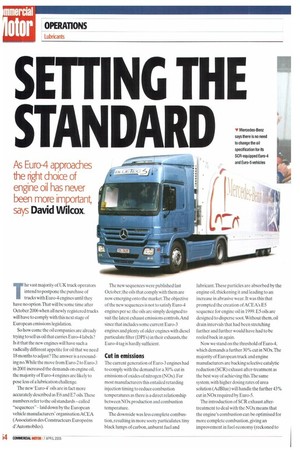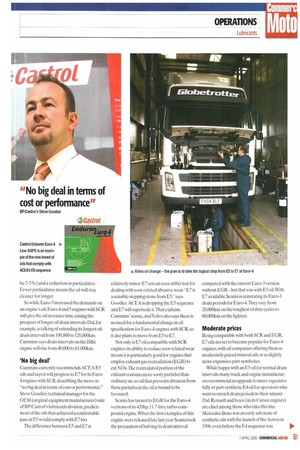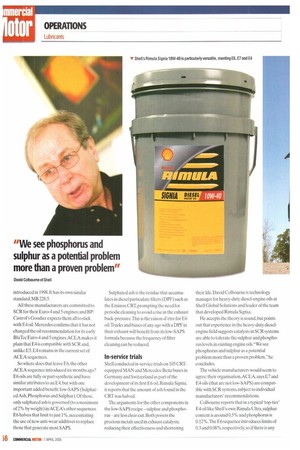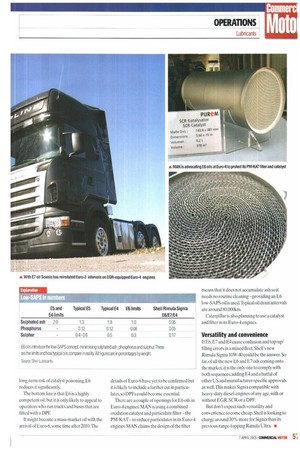SETTING THE " STAN DAR
Page 54

Page 55

Page 56

Page 57

If you've noticed an error in this article please click here to report it so we can fix it.
As Euro-4 approaches the right choice of engine oil has never been more important,
says David Wilcox The vast majority of UK truck operators intend to postpone the purchase of trucks with Euro-4 engines until they have no option.That will be some time after October 2006 when all newly registered trucks will have to comply with this next stage of European emissions legislation.
So how come the oil companies are already trying to sell us oil that carries Euro-4 labels? Is it that the new engines will have such a radically different appetite for oil that we need 18 months to adjust? The answer is a resounding no. While the move from Euro-2 to Euro-3 in 2001 increased the demands on engine oil, the majority of Euro-4 engines are likely to pose less of a lubrication challenge.
The new -Euro-4' oils are in fact more accurately described as E6 and E7 oils. These numbers refer to the oil standards —called "sequences"— laid down by the European vehicle manufacturers' organisation ACEA (Association des Constructeurs Europeens d'Automobiles). The new sequences were published last October; the oils that comply with them are now emerging onto the market.The objective of the new sequences is not to satisfy Euro-4 engines per se: the oils are simply designed to suit the latest exhaust emissions controlsAnd since that includes some current Euro-3 engines and plenty of older engines with diesel particulate filter (DPFs) in their exhausts. the Euro-4 tag is hardly sufficient.
Cut in emissions The current generation of Euro-3 engines had to comply with the demand for a 30% cut in emissions of oxides of nitrogen (NOx). For most manufacturers this entailed retarding injection timing to reduce combustion temperatures as there is a direct relationship between NOx production and combustion temperature.
The downside was less complete combustion, resulting in more sooty particulates: tiny black lumps of carbon, unburnt fuel and lubricant. These particles are absorbed by the engine oil, thickening it and leading to an increase in abrasive wear. It was this that prompted the creation of ACEA's E5 sequence for engine oil in 1999. E5 oils are designed to disperse soot.Without them, oil drain intervals that had been stretching further and further would have had to be reeled back in again.
Now we stand on the threshold of Euro-4. which demands a further 30% cut in NOx.The majority of European truck and engine manufacturers are backing selective catalytic reduction (SCR) exhaust after-treatment as the best way of achieving this.The same system, with higher dosing rates of urea solution (AdBlue) will handle the further 43% cut in NOx required by Euro-5.
The introduction of SCR exhaust aftertreatment to deal with the NOx means that the engine's combustion can be optimised for more complete combustion, giving an improvement in fuel economy (reckoned to be 2-3%) and a reduction in particulates. Fewer particulates means the oil will stay cleaner for longer.
So while Euro-3 increased the demands on an engine's oil. Euro-4 and 5 engines with SCR will give the oil an easier time, raising the prospect of longer oil drain intervals Daf, for example, is talking of extending its longest oil drain interval from 100,000 to 120,000km. Cummins says drain intervals on the ISBe engine will rise from 40,000 to 65,000km.
No big deal'
Cummins currently recommends ACEA E5 oils and says it will progress to E7 for its Euro-. 4 engines with SCR, describing the move as "no big deal in terms of cost or performance." Steve Goodier, technical manager for the OEM (original equipment manufacturer) side of BP/Castrol's lubricants division,predicts most of the oils that achieved a comfortable pass at E5 would comply with E7 too.
The difference between E5 and E7 is relatively minor: E7 sets an even stiffer test for dealing with soot-related abrasive wear. "E7 is a sensible stepping stone from E5," says Goodier.ACEA is dropping the E5 sequence and E7 will supersede it.That explains Cummins' stance, and Volvo also says there is no need for a fundamental change in oil specification for Euro-4 engines with SCR, so it also plans to move from E5 to E7.
Not only is E7 oil compatible with SCR engines; its ability to reduce soot-related wear means it is particularly good for engines that employ exhaust gas recirculation (EGR) to cut NOx.The recirculated portion of the exhaust contains more sooty particles than ordinary air, so oil that prevents abrasion from these particles in the oil is bound to be favoured.
Scania has turned to EGR for the Euro-4 versions of its 420hp,11.7-litre turbo-compound engine. When the first examples of this engine were released late last year Scania took the precaution of halving its drain interval compared with the current Euro-3 version without EGRbut that was with E5 oiL With E7 available, Scania is reinstating its Euro-3 drain periods for Euro-4.They vary from 20,000km on the toughest of duty cycles to 60,000km on the lightest.
Moderate prices
Being compatible with both SCR and EGR, E7 oils are set to become popular for Euro-4 engines, with oil companies offering them as moderately priced mineral oils or as slightly more expensive part-synthetics.
While happy with an E5 oil for normal drain intervals, many truck and engine manufacturers recommend an upgrade to more expensive fully or part-synthetic E4 oil for operators who want to stretch drain periods to their utmost. Daf, Renault and Iveco (in its Cursor engines) are chief among those who take this line. Mercedes-Benz was an early advocate of synthetic oils with the launch of the Actros in 1996. even before the E4 sequence was introduced in 1998.11 has its own similar standard,MB 228.5.
All these manufacturers are committed to SCR for their Euro-4 and 5 engines; and BP/ Castrol's Goodier expects them all to stick with E4 oil. Mercedes confirms that it has not changed the oil recommendation for its early BluTec Euro-4 and 5 engines. ACEA makes it plain that E4 is compatible with SCR and, unlike E5.E4 remains in the current set of AEA sequences.
So where does that leave E6, the other ACEA sequence introduced six months ago? E6 oils are fully or part-synthetic and have similar attributes to an E4, but with one important added benefit: low-SAPS (Sulphated Ash, Phosphorus and Sulphur). Of these, only sulphated ash is governed (to a maximum of 2% by weight) inACEA's other sequences. E6 halves that limit to just 1%, necessitating the use of new anti-wear additives to replace those that generate most SAPS. Sulphated ash is the residue that accumulates in diesel particulate filters (DPF) such as the Eminox CRT, prompting the need for periodic cleaning to avoid a rise in the exhaust back-pressure.This is the raison-d'etre for E6 oil Trucks and buses of any age with a DPF in their exhaust will benefit from its low-SAPS formula because the frequency of filter cleaning can be reduced.
In-service trials
Shell conducted in-service trials on 105 CRTequipped MAN and Mercedes-Benz buses in Germany and Switzerland as part of the development of its first E6 oil. Rimula Signia; it reports that the amount of ash found in the CRT was halved.
The arguments for the other components in the low-SAPS recipe—sulphur and phosphorus —are less clear-cut. Both poison the precious metals used in exhaust catalysts, reducing their effectiveness and shortening their life. David Colbourne is technology manager for heavy-duty diesel-engine oils at Shell Global Solutions and leader of the team that developed Rimula Signia.
He accepts the theory is sound, but points out that experience in the heavy-duty dieselengine field suggests catalysts in SCR systems are able to tolerate the sulphur and phosphorus levels in existing engine oils. "We see phosphorus and sulphur as a potential problem more than a proven problem," he concludes.
The vehicle manufacturers would seem to agree: their organisation,ACEA, says E7 and E4 oils (that are not low-SAPS) are compatible with SCR systems, subject to individual manufacturers' recommendations.
Colbourne reports that in a typical 'top-tier' E4 oil like Shell's own Rimula Ultra, sulphur content is around 0.5 % and phosphorus is 0.12% .The E6 sequence introduces limits of 0.3 and 0.08% respectively,so if there is any long-term risk of catalyst poisoning, E6 reduces it significantly.
The bottom line is that E6 is a highly competent oil, but it is only likely to appeal to operators who run trucks and buses that are fitted with a DPE It might become a mass-market oil with the arrival of Euro-6,some time after 2010.The details of Euro-6 have yet to be confirmed but it is likely to include a further cut in particulates, so DPFs could become essential.
There are a couple of openings for E6 oils in Euro-4 engines, MAN is using a combined oxidation catalyst and particulate filter — the PM-KAT— to reduce particulates in its Euro-4 engines. MAN claims the design of the filter means that it does not accumulate ash so it needs no routine cleaning — providing an E6 low-SAPS oil is used.Typical oil drain intervals are around 80,0001un.
Caterpillar is also planning to use a catalyst and filter in its Euro-4 engines.
Versatility and convenience If E6, E7 and E4 cause confusion and top-up/ filling errors in a mixed fleet. Shell's new Rimula Signia 10W-40 could be the answer. So far, of all the new E6 and E7 oils coming onto the market. it is the only one to comply with both sequences, adding E4 and a hatful of other US and manufacturer-specific approvals as well.This makes Signia compatible with heavy-duty diesel-engines of any age, with or without EGR. SCR or a DPF.
But don't expect such versatility and convenience to come cheap. Shell is looking to charge around 30% more for Signia than its previous range-topping Rimula Ultra. I
















































































































































































































